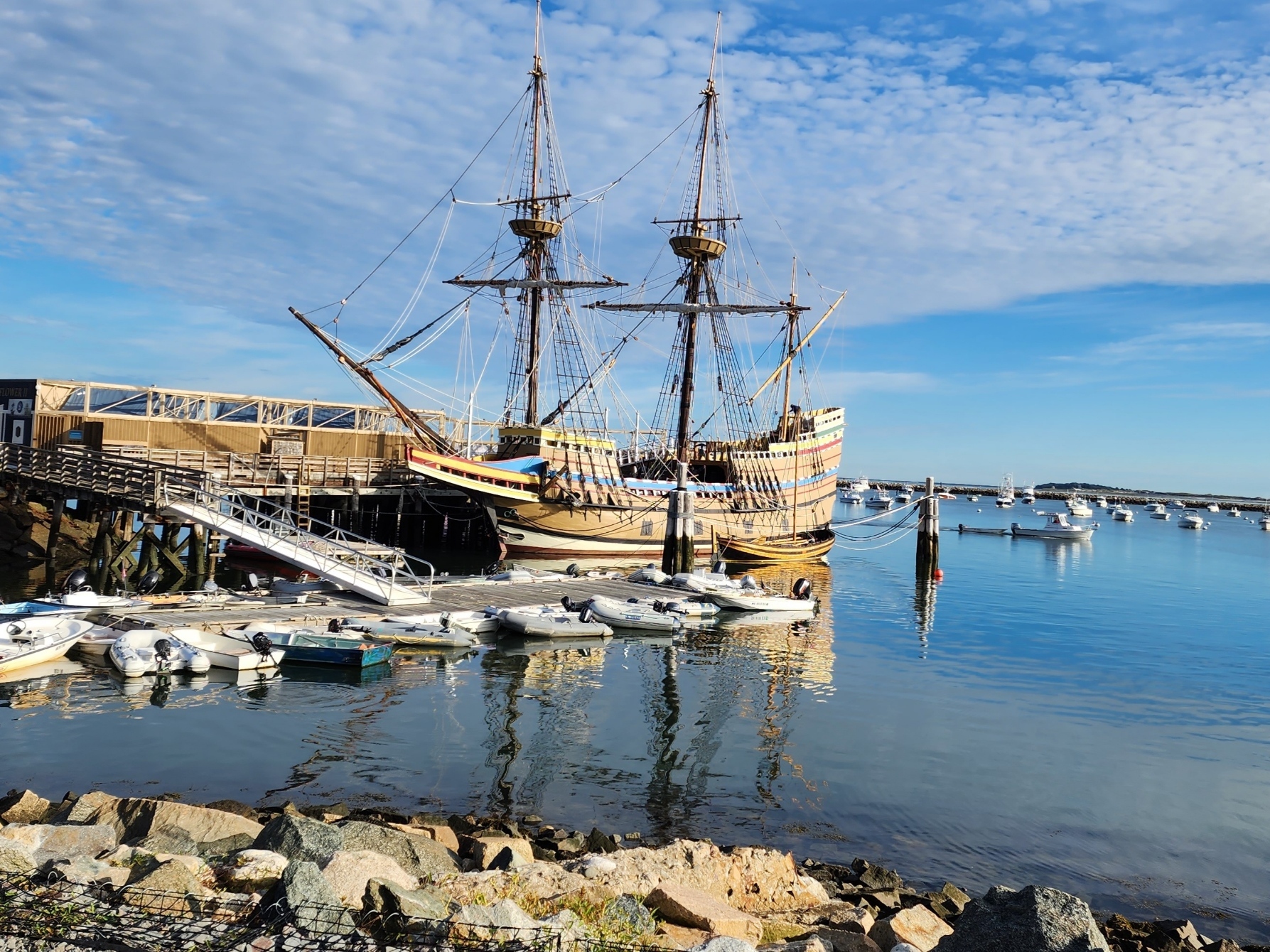To get credit for this virtual, please submit a photo with the Mayflower II AND your GPS, a personal item, or yourself/group.
From https://en.wikipedia.org/wiki/Mayflower:
Mayflower was square rigged with a beakhead bow and high, castle-like structures fore and aft that protected the crew and the main deck from the elements: designs that were typical of English merchant ships of the early 17th century. Her stern carried a 30-foot high, square aft-castle which made the ship difficult to sail close to the wind and not well suited against the North Atlantic's prevailing westerlies, especially in the fall and winter of 1620; the voyage from England to America took more than two months as a result. Mayflower's return trip to London in April–May 1621 took less than half that time, with the same strong winds now blowing in the direction of the voyage.
Mayflower's exact dimensions are not known, but she probably measured about 100 feet from the beak of her prow to the tip of her stern superstructure, about 25 feet at her widest point, and the bottom of her keel about 12 feet below the waterline. William Bradford estimated that she had a cargo capacity of 180 tons, and surviving records indicate that she could carry 180 casks holding hundreds of gallons each. The general layout of the ship was as follows:
- Three masts: mizzen (aft), main (midship), and fore, and also a spritsail in the bow area
- Three primary levels: main deck, gun deck, and cargo hold
Aft on the main deck in the stern was the cabin for Master Christopher Jones, measuring about ten by seven feet. Forward of that was the steerage room, which probably housed berths for the ship's officers and contained the ship's compass and whipstaff (tiller extension) for sailing control. Forward of the steerage room was the capstan, a vertical axle used to pull in ropes or cables. Far forward on the main deck, just aft of the bow, was the forecastle space where the ship's cook prepared meals for the crew; it may also have been where the sailors slept.
The poop deck(a poop deck is a deck that forms the roof of a cabin built in the rear) was located on the ship's highest level above the stern on the aft castle and above Master Jones' cabin. On this deck stood the poop house, which was ordinarily a chart room or a cabin for the master's mates on most merchant ships, but it might have been used by the passengers on Mayflower, either for sleeping or cargo.
The gun deck was where the passengers resided during the voyage, in a space measuring about 50 by 25 feet with a five-foot ceiling. It was a dangerous place if there was conflict, as it had gun ports from which cannon would be run out to fire on the enemy. The gun room was in the stern area of the deck, to which passengers had no access because it was the storage space for gunpowder and ammunition. The gun room might also house a pair of stern chasers, small cannon used to fire from the ship's stern. Forward on the gun deck in the bow area was awindlass, similar in function to the steerage capstan, which was used to raise and lower the ship's main anchor. There were no stairs for the passengers on the gun deck to go up through the gratings to the main deck, which they could reach only by climbing a wooden or rope ladder.
Below the gun deck was the cargo hold where the passengers kept most of their food stores and other supplies, including most of their clothing and bedding. It stored the passengers' personal weapons and military equipment, such as armor, muskets, gunpowder and shot, swords, and bandoliers. It also stored all the tools that the Pilgrims would need, as well as all the equipment and utensils needed to prepare meals in the New World. Some Pilgrims loaded trade goods on board, including Issac Allerton, William Mullins, and possibly others; these also most likely were stored in the cargo hold. There was no privy on Mayflower; passengers and crew had to fend for themselves in that regard. Gun deck passengers most likely used a bucket as a chamber pot, fixed to the deck or bulkhead to keep it from being jostled at sea.
Mayflower was heavily armed; her largest gun was a minion cannon which was brass, weighed about 1,200 pounds, and could shoot a 3.5 pound cannonball almost a mile. She also had a saker cannon of about 800 pounds, and two base cannons that weighed about 200 pounds and shot a 3 to 5 ounce ball. She carried at least ten pieces of ordnance on the port and starboard sides of her gun deck: seven cannons for long-range purposes, and three smaller guns often fired from the stern at close quarters that were filled with musket balls. Ship's Master Jones unloaded four of the pieces to help fortify Plymouth Colony.

Virtual Rewards 3.0 - 2022-2023
This Virtual Cache is part of a limited release of Virtuals created between March 1, 2022 and March 1, 2023. Only 4,000 cache owners were given the opportunity to hide a Virtual Cache. Learn more about Virtual Rewards 3.0 on the Geocaching Blog.